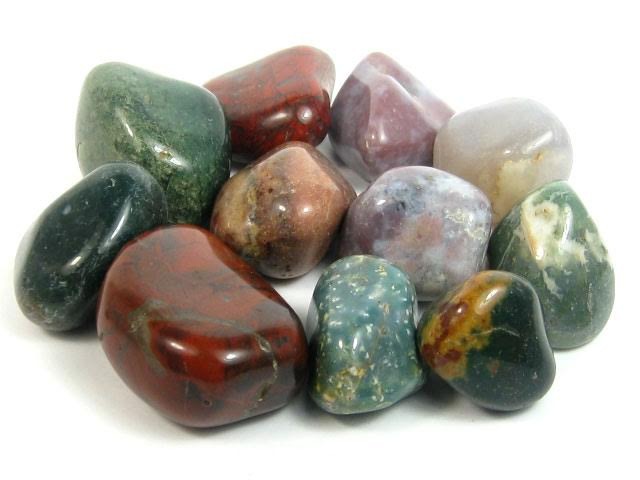Jasper

Hello again, and welcome back to "All That Glitters"! While my interest in fashion certainly drew me into the world of gems, there's so much more then just glitter and shine to these beauties. They have also been used for medicine, magic, and all things in between. So let's get started with this month's stone, Jasper!
Now, Jasper is maybe not the most glittery stone out there, but what it lacks in sparkle, it makes up for in colors and patterns. Not only can it be found in all sorts of colors (including lovely fall hues such as browns and reds), it's also not uncommon for it to have striation, marbling, rings, speckles, or more throughout. It's an opaque stone, with a smooth surface, and, due to the impurities in it, each piece is unique. You won't catch anyone with the same exact stone as you! And while you shouldn't use any harsh chemicals on jasper, it's quite durable and can handle being washed in warm water. Which is a relief if you forget to take off your rings before washing your hands.
Jasper has been around for centuries. Just about every ancient culture mentioned or used jasper, and it's even mentioned in the Bible as part of the breastplate for the High Priest. One of the more famous ancient jasper pieces is a piece of yellow jasper from Ancient Egypt, carved into the face of a famous queen. Unfortunately, the statue is broken, so it's hard to tell which queen it's supposed to represent, but it's usually attributed to Queen Tiye, though Queen Kiya or the famous beauty Nefertiti are also possible candidates.
The word Jasper comes from a combination of old French (jaspre) and Greek (iaspis), and translates to "speckled stone". But, frankly, due to its popularity, the word can be traced all over the world. From Arabic to Hebrew, to Assyrian to Latin, each culture had a word for this stone. Not surprisingly, as it's also mined around the world. Some of the most common pieces come from Egypt or Africa (as some are classified by those countries), while some of the most unique (e.g., picture jasper, which comes with a specific banding or pattern) come from Brueneu River, Idaho or the Llanddwyn Island in Wales. There's also a black, flinty type of jasper (also called basanite), found in several New England states.
Due to its popularity and range, jasper has had numerous uses. It's been used not in only in jewelry, but also for decorative boxes, vases, and seals. Beyond its decorative uses, it was also used as bow drills in the 4th and 5th BC. In fact, there are reasons to believe that it was even used as as weapon in Ethiopia. Beautiful and deadly, my kind of stone! Jasper is also used as a touchstone for testing precious metal alloys. This is done by drawing a line with the metal they wish to test (gold in this case) on the stone, allowing them to check the metal against known purity samples and to know exactly how much gold is really in the alloy. It's a practice dating back to the Greeks, and while we have other ways to test these this now, it's still a common practice.
Additionally, jasper has been used in magic and healing practices around the world. Due to the variety of colors, its uses are wide-ranging, depending on the colors. Like opalite, jasper is supposed to help you sleep, whereas poppy jasper is meant to inspire joy in your life, and plum jasper is supposed to help with memory (I could use some of that!). A common thread, though, for all jasper types is that they are considered to be grounding or protective stones, due to their earthy nature. They are also heavily associated with the Zodiac Leo, Virgo, and Scorpio; the months October and March, as well as the planets Mars and Jupiter (an association that started back in the medieval era).
Jasper is also supposed to be great for balancing and realigning the chakras, particularly the base. In the metaphysical world, it's used a lot in two fairly different directions: healers and warrior types. When used for healer types (such as therapists or counselors), it helps to balance out any negative energy they're handling, as well as to nurture their spirits. Jasper can also be used for therapists' clients or patients, particularly if they are struggling to let go of an obsessive or compulsive behavior. So, if I hang a jasper over my cell phone, does that mean I'll use it less? On the flip side, or warrior side, it's meant to help you to speak up, particularly in matters of justice or fair play, as well as to help you to focus. This makes it a particularly nice gift for lawyers, advocates, judges, even police officers.
And as for healing, jasper's uses were wide-ranging, too. From troubled toenails to sciatica, pancreatic disorders to stomach issues, jasper was handy to have in your gemstone medical kit. It was said to be especially useful for prolonged illnesses, due to its ability to re-energize the body and alleviate symptoms. And administering the care was usually pretty easy. Just hold or wear the stone where it would lay on the afflicted place. Though that might have been a tad harder for the feet, but hey, anklets are pretty, right? Also, in at least one place, it's been noted to help with a loss of smell. Not sure how, but hey, good to cover all the bases.
So, jasper...pretty, easy to find, and useful! Definitely a nice stone to have around. I know I promised topaz last time, but I was so intrigued by the uses (and the colors/patterns, let's be honest) of jasper, that I'll do topaz next time. Promise!
Until then!






